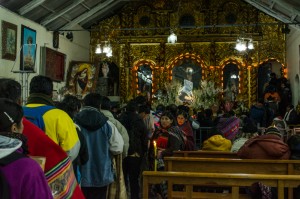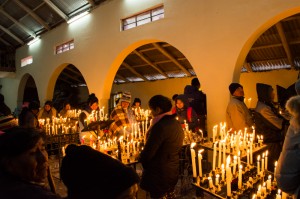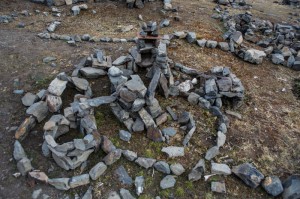Making Desires Real in Qoyllur Rit’i

“Your dreams can become reality” proclaimed a sign by the food court in Cuzco’s new mall. While it refers to how the market claims dreams in order to make them real through the act of purchase, there are many other ways desire flowers and becomes fruit in Cuzco.
Perhaps the most important, besides the capitalist dream team, takes place this month. Already, people in the city are asking each other if they are going to Qoyllur Rit’i In the process they tell experiences of going in prior years and how their desires were made real when they made the pilgrimage to Qoyllur Rit’i *.
People are deciding whether to go or not, and troupes of dancers, already committed parade through the city building their courage and also raising money for the trip.
Going to Qoyllur Rit’i where an image of Christ sits on native stone and a tropical glacier transforms a crag into a valley at the top of the world, is never easy.To get there you take a ride to Mawayani, just a spot near the high pass on the new Interoceanic Highway that connects Brazil’s and Peru’s coasts across an enormous and difficult continent.

Generally you arrive at night and start a six or more hour climb up to the shrine in Sinacara.The first section is reportedly quite steep after which the rise levels off a bit.You climb in the dark and cold, your face and any other body parts covered, a climbing stick in your hand preferably and good hiking shoes on.

Near dawn, the coldest part of the day, you arrive at the rustic chapel and a large encampment of pilgrims.Lines of people wait to go into the chapel and pay their respects to the rock with its image of Christ, among them costumed dancers.
Troupes of Ukukus, the half-bear-half human heros who are said to fight condenados (the suffering souls who cannot make a transition from this life and attack living people) climb to the glacier, near the very high mountain peaks and return, sometimes leaving friends forever in crevasses.
People carry out many other rituals, including those of cleansing, taking their household images to get charged with strength (energy) from the site, carrying vows inside, listening to mass, payments to the mountain, and playing games.
Yes playing. Sacred games are played in Pucllanapata, the terrace of games, above the main chapel near the shrine of the Virgin of Fatima and at base of Qollqepunku, the gate of Silver (or maybe we should call it the gate of desire’s fulfillment), the mountain which holds the glaciers.

The word pucllay in Quechua means play, primarily, and in Spanish it is translated as jugar. People actually say they play games at Qoyllur Rit’i and that the games are very important because they lead to what you wish to have or be in real life. Game, here, takes the place of the market transactions that reign supreme in the mall
Pucllay is also a word used in Quechua to describe Carnival during the high rainy season and the contests of fertility that take place during it. In Qoyllur Rit’ì, for all those who wish to make dreams real, games take the place of the market transactions that reign supreme in the mall.
However, in my English all this sounds strange. Games and play are generally the place of leisure and the non-serious. They are defined agains those things such as religion, government, education, the economy and such that we see as important. After all, who thinks of monopoly as all that serious, like in a religious, devotional sense, or like in the sense of hard cash exchanging hands in a mall, while goods are packaged and transferred in the opposite direction?
This is unfortunate, because even English has an ancient sense of play as holy and sacred, despite the rather strange question of whether God will play dice with the universe.
Unlike what is thought in English, these are games that must be taken with great seriousness. People here say you must carry them out with “faith”. You expect what is represented in play will become real. Performance and full expectation are the currency and the market.
In Qoyllur Ri’ti, like in Copacabana there is play money that is used to make payments, but here, unlike int he market, it is not the money that unchains the bounds of dreams becoming reality, rather it is the performance with full faith — the actions in which the money is found.

What kinds of games do people carry out? A mother might stage a date for a young man who is too shy to ask a girl out on his own. She will ask a woman passing by if she will play the role of girlfriend for a bit while giving them money to go to the movies and buy popcorn, all within a rocked off space of Pucllanapata.
People might ask a passerby to sign and give them title to a new house they just bought.
Or they might make houses of rocks and live in them. They will perform as bosses, owners, directors, people with titles, and so on.
The material accoutrements of these performances, the props–so to speak– are miniatures that people can buy and have blessed so they will become animated with power to become real if reality is performed.
In all of this is one of the ways Cuzqueños create wealth: the path of life manifested in the multistoried houses rising in the city, the cars and trucks that fill its streets, the offices, businesses, schools, and jobs, all filled by people. And, yes, even an understanding of how people make dreams real in the mall.
It is not the explanation or method of economists and their politician buddies who like free markets and think the world hinges on flows of money. That world is part of Cuzco too. But for many, of not most Cuzqueños, the world of the mall and the new airport gets embedded in this other world of games, faith, and performance as part of pilgrimage.
Qoyllur Rit’i marks the beginning of winter. As winter’s end nears, in August, people will once again carry out another economic and spiritual act. They will make offerings to the Pachamama, the earth–or the lady of time and space, so that their homes, offices, cars, and all such will be blessed with good fortune and especially with fertility, the ability to create abundance.
Along the way, they will worry about maintaining luck and abundance, through keeping rue, amulets in their wallets and around them, spiny crosses of cactus on their door, their dreams, all as Qoyllur Rit’i rollas around again.This is a code, if not the code, of Cuzco.

* Note on a Name:
If you look at the literature you will see many ways of spelling Qoyllur Rit’i as well as all kinds of definitions. Many of these have political intent and are shrouded with power. I choose to try to stay close to the Quechua. Qoyllur means star and Rit’i means snow. I add the apostrophe after the t to indicate the glottal stop spoken in Cuzco Quechua.
Since adjective precede nouns in Quechua, the best translations should honor that when moving the term into either Spanish of English. Literally it would be something like “Star Snow” or “Starry Snow”, as a result anthropologists have noted the association of the feast with the seasonal reappearance of the pleiades int eh night sky. Other anthropologists argue it is a quality of the star, namely shining, that should be emphasized. here then it would mean shiny or shining snow. I will leave it at this. Most everything about Qoyllur Rit’i is contested by someone, even though the pilgrimage and its economy is very important both int eh city of Cuzco and in rural Cuzco and Puno.




